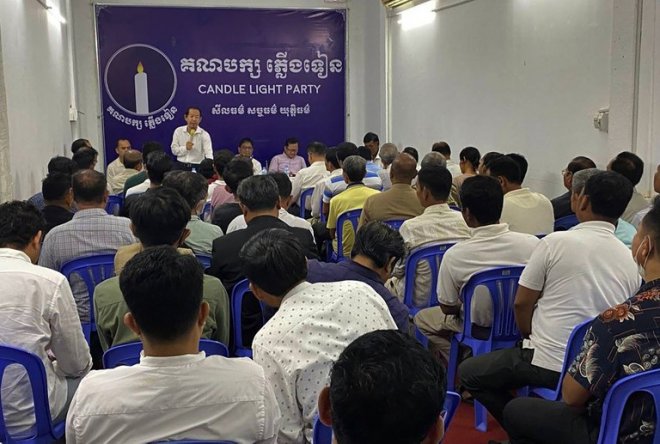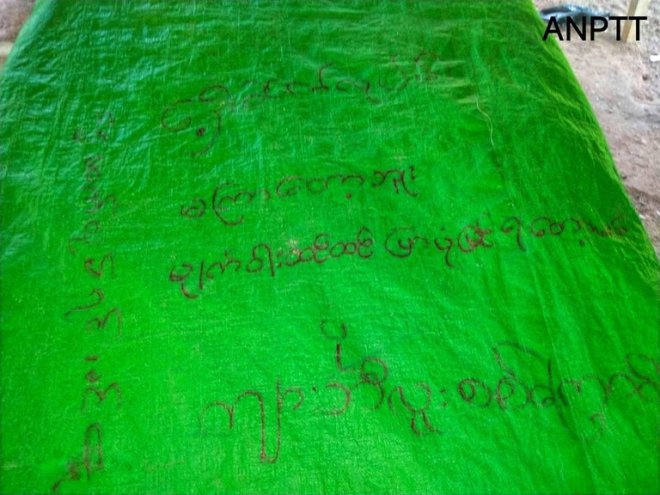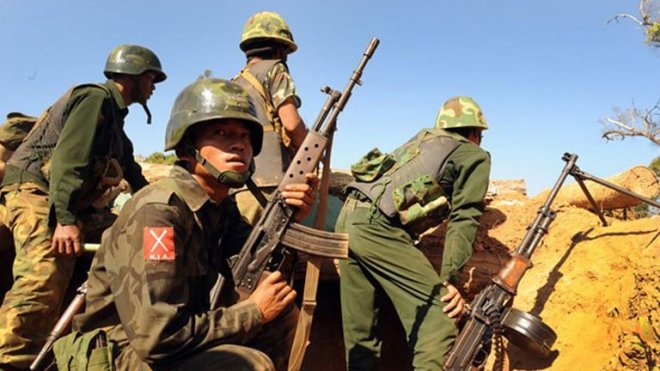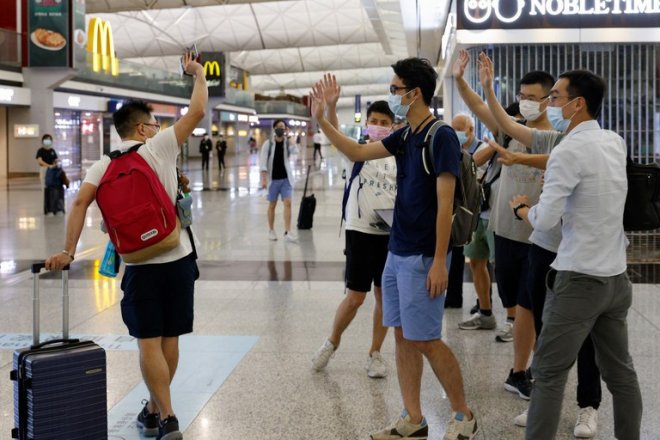Rapes and massacres detailed in Rohingya genocide case against Myanmar authorities
Women gang raped, children stabbed and killed, men shot and burned to death.
The criminal complaint of genocide by Myanmar’s armed forces against the Muslim Rohingya minority includes detailed accounts of stomach-churning atrocities.
Argentina accepted the case under the principle of “universal jurisdiction,” in which crimes that are especially abhorrent can be taken by any country.
Hearings at a federal court in Buenos Aires, set to end Tuesday, include in-person testimony from Rohingya witnesses – a historic first. For security reasons the case is being held behind closed doors.
“The net is closing in around Myanmar’s military leaders. This trial shows that they cannot hide from justice anywhere in the world,” said Tun Khin, head of the Burmese Rohingya Organisation UK, or BROUK, the London-based advocacy group that brought the case.
The case centers on abuses committed in Myanmar between 2012 and 2018. Those named include military junta leader Senior General Min Aung Hlaing, radical Buhddist cleric Ashin Wirathu, and ousted civilian leader Aung Sang Suu Kyi.
Tomas Ojea Qintana, who was United Nations Special Rapporteur on human rights in Myanmar between 2008 and 2014, is representing BROUK in court.
Much of the case is based on Ojea Quintana’s own work in the region, the work of his successor Yanghee Lee, and reports submitted in 2018 and 2019 by a United Nations “Independent International Fact-Finding Mission on Myanmar.”
Easy Target
The Rohingya live in the impoverished western state of Rakhine, which borders the Bay of Bengal and Bangladesh. They shared the region with other groups, mainly the Buddhist ethnic Rakhine.
According to the criminal complaint, the “genocidal final plan” against the Rohingya was born in 2012, when a nominally elected military government, seeking support from the country’s Buddhist majority, began to promote hatred towards Myanmar’s Muslims and especially the Rohingya.
The Rohingya, who had faced various forms of discrimination for decades, were an easy target.
![]() A Rohingya refugee boy looks at Senuwara Begum, 16, as she walks to her family"s makeshift shelter with the help of a pair of donated crutches at Balukhali refugee camp near Cox"s Bazar, Bangladesh, Nov. 30, 2017. Senuwara Begum lost her right leg after she got shot in the thigh, above the knee, when her village, Shahab Bazar, in Maungdaw district, Myanmar, was attacked and burned to the ground by the Myanmar military at the end of August 2017, her father, Sayedul Rahaman, says. Credit: Susana Vera/Reuters
A Rohingya refugee boy looks at Senuwara Begum, 16, as she walks to her family"s makeshift shelter with the help of a pair of donated crutches at Balukhali refugee camp near Cox"s Bazar, Bangladesh, Nov. 30, 2017. Senuwara Begum lost her right leg after she got shot in the thigh, above the knee, when her village, Shahab Bazar, in Maungdaw district, Myanmar, was attacked and burned to the ground by the Myanmar military at the end of August 2017, her father, Sayedul Rahaman, says. Credit: Susana Vera/Reuters
“In a coordinated manner among all state entities, the use of the name Rohingya began to be forbidden,” replaced by the generic term “Bengalis,” the complaint reads.
A campaign, fueled by radical Buddhist priests, then spread the idea that the tiny Muslim minority was plotting “to take over the country and convert it to Islam.”
Two waves of violence broke out in October 2012 in Rakhine State, affecting 12 townships. Further violence broke out in the town of Thandwe in 2013. At the time authorities dismissed the incidents as “intercommunal unrest.”
The attacks against the Rohingya and another Muslim ethnic group, the Kaman, were really part of a months-long plan “to instigate violence and amplify tensions” fueled by “various Rakhine organizations, radical Buddhist monk organizations, and several officials and influential figures,” the complaint reads.
Security forces “were at least complicit, often failing to intervene to stop the violence, or actively participated.”
‘Genocidal plan’
Witnesses in the towns of Sittwe and Kyaukpyu said police and soldiers stopped people from extinguishing fires set by Rakhine mobs, while witnesses at Maungdaw “described security forces shooting indiscriminately at Rohingya and conducting mass arrests.”
Some 140,000 people were displaced, mostly fleeing to Bangladesh.
Following the November 2015 elections which ushered in Aung San Suu Kyi’s civilian government, “the genocidal plan was perfected,” the complaint states.
“In a cruel twist of history” this allowed for “the worst atrocities to be committed under the authority of those who had fought with their lives for democratic freedoms, human rights and peace,” it says.
![]() A burned Rohingya village near Maungdaw, northern Rakhine state, Myanmar, is seen Nov. 12, 2017. Picture taken November 12, 2017. Credit: Wa Lone/Reuters
A burned Rohingya village near Maungdaw, northern Rakhine state, Myanmar, is seen Nov. 12, 2017. Picture taken November 12, 2017. Credit: Wa Lone/Reuters
Violence escalated dramatically in August 2017 when the Arakan Rohingya Salvation Army – a small, poorly armed resistance group – attacked security forces across northern Rakhine state, killing 12 people.
The military response, “launched within hours, was immediate, brutal and grossly disproportionate,” encompassing hundreds of villages in so-called “clearance operations.” Within a year nearly 725,000 Rohingya had fled to Bangladesh, with an estimated 10,000 people killed.
“Rape and other forms of sexual violence were perpetrated on a massive scale. Large scale gang rape was perpetrated by Tatmadaw soldiers in at least 10 village tracts” in Rakhine state, the complaint said.
Massacres
People were shot dead indiscriminately by soldiers, while others were burned to death in their homes. Rakhine men often joined the soldiers wielding long knives and machetes.
“Sometimes up to 40 women and girls were raped or gang-raped together,” often in public and in front of their families “to maximize humiliation.” Men and boys were not spared “genital mutilation and sexualized torture,” the document reads.
Of the approximately 500,000 Rohingya children currently in Bangladesh, “many fled alone after their parents were killed or after being separated from their families.”
![]() Rohingya refugee Nur Kamal, 17, poses for a photograph to show his head injuries, at Kutupalong refugee camp, near Cox"s Bazar in Bangladesh, Oct. 13, 2017. Kamal says soldiers “hit me with a rifle butt on my head first and then with a knife” after they found the young shopkeeper hiding in his home in Kan Hpu village in Maungdaw, Myanmar. Credit: Jorge Silva/Reuters
Rohingya refugee Nur Kamal, 17, poses for a photograph to show his head injuries, at Kutupalong refugee camp, near Cox"s Bazar in Bangladesh, Oct. 13, 2017. Kamal says soldiers “hit me with a rifle butt on my head first and then with a knife” after they found the young shopkeeper hiding in his home in Kan Hpu village in Maungdaw, Myanmar. Credit: Jorge Silva/Reuters
In a particularly heinous incident on August 30, 2017, soldiers and armed ethnic Rakhine stormed the village of Min Gyi and attacked Rohingya who had taken refuge there.
Soldiers opened fire on people trying to flee. Villagers who surrendered were rounded up, and women and children were separated from the men.
The men were slaughtered and their bodies dumped into three pits, doused gasoline and set ablaze.
Women and girls were taken into rooms where they were robbed, raped and stabbed. Children and infants were killed or stabbed.
“All interviewees identified Tatmadaw soldiers as the main perpetrators,” the complaint says, adding that ethnic Rakhine “and members of other ethnic minorities participated.”
At least 750 people died in that attack.
Downplayed
Aung San Suu Kyi, then head of Myanmar’s civilian government, downplayed the violence when presented with evidence, describing it as “fake news” and “an iceberg of misinformation.”
Two other international court cases are attempting to hold Myanmar’s authorities accountable.
In 2019 the International Criminal Court began looking into abuses against Rohingya on the border with Bangladesh. Myanmar is not a member of the ICC, but Bangladesh is, so this probe is limited in scope.
And in November 2020 The Gambia filed a case focusing on Myanmar’s responsibility as a state for the Rohingya genocide at the UN’s top court, the International Court of Justice.
“Argentina is on the other side of the world from Myanmar but even here the Burmese military cannot escape justice,” plaintiff Tun Kihn said.
Edited by Malcolm Foster.
[圖擷取自網路,如有疑問請私訊]
The criminal complaint of genocide by Myanmar’s armed forces against the Muslim Rohingya minority includes detailed accounts of stomach-churning atrocities.
Argentina accepted the case under the principle of “universal jurisdiction,” in which crimes that are especially abhorrent can be taken by any country.
Hearings at a federal court in Buenos Aires, set to end Tuesday, include in-person testimony from Rohingya witnesses – a historic first. For security reasons the case is being held behind closed doors.
“The net is closing in around Myanmar’s military leaders. This trial shows that they cannot hide from justice anywhere in the world,” said Tun Khin, head of the Burmese Rohingya Organisation UK, or BROUK, the London-based advocacy group that brought the case.
The case centers on abuses committed in Myanmar between 2012 and 2018. Those named include military junta leader Senior General Min Aung Hlaing, radical Buhddist cleric Ashin Wirathu, and ousted civilian leader Aung Sang Suu Kyi.
Tomas Ojea Qintana, who was United Nations Special Rapporteur on human rights in Myanmar between 2008 and 2014, is representing BROUK in court.
Much of the case is based on Ojea Quintana’s own work in the region, the work of his successor Yanghee Lee, and reports submitted in 2018 and 2019 by a United Nations “Independent International Fact-Finding Mission on Myanmar.”
Easy Target
The Rohingya live in the impoverished western state of Rakhine, which borders the Bay of Bengal and Bangladesh. They shared the region with other groups, mainly the Buddhist ethnic Rakhine.
According to the criminal complaint, the “genocidal final plan” against the Rohingya was born in 2012, when a nominally elected military government, seeking support from the country’s Buddhist majority, began to promote hatred towards Myanmar’s Muslims and especially the Rohingya.
The Rohingya, who had faced various forms of discrimination for decades, were an easy target.
 A Rohingya refugee boy looks at Senuwara Begum, 16, as she walks to her family"s makeshift shelter with the help of a pair of donated crutches at Balukhali refugee camp near Cox"s Bazar, Bangladesh, Nov. 30, 2017. Senuwara Begum lost her right leg after she got shot in the thigh, above the knee, when her village, Shahab Bazar, in Maungdaw district, Myanmar, was attacked and burned to the ground by the Myanmar military at the end of August 2017, her father, Sayedul Rahaman, says. Credit: Susana Vera/Reuters
A Rohingya refugee boy looks at Senuwara Begum, 16, as she walks to her family"s makeshift shelter with the help of a pair of donated crutches at Balukhali refugee camp near Cox"s Bazar, Bangladesh, Nov. 30, 2017. Senuwara Begum lost her right leg after she got shot in the thigh, above the knee, when her village, Shahab Bazar, in Maungdaw district, Myanmar, was attacked and burned to the ground by the Myanmar military at the end of August 2017, her father, Sayedul Rahaman, says. Credit: Susana Vera/Reuters “In a coordinated manner among all state entities, the use of the name Rohingya began to be forbidden,” replaced by the generic term “Bengalis,” the complaint reads.
A campaign, fueled by radical Buddhist priests, then spread the idea that the tiny Muslim minority was plotting “to take over the country and convert it to Islam.”
Two waves of violence broke out in October 2012 in Rakhine State, affecting 12 townships. Further violence broke out in the town of Thandwe in 2013. At the time authorities dismissed the incidents as “intercommunal unrest.”
The attacks against the Rohingya and another Muslim ethnic group, the Kaman, were really part of a months-long plan “to instigate violence and amplify tensions” fueled by “various Rakhine organizations, radical Buddhist monk organizations, and several officials and influential figures,” the complaint reads.
Security forces “were at least complicit, often failing to intervene to stop the violence, or actively participated.”
‘Genocidal plan’
Witnesses in the towns of Sittwe and Kyaukpyu said police and soldiers stopped people from extinguishing fires set by Rakhine mobs, while witnesses at Maungdaw “described security forces shooting indiscriminately at Rohingya and conducting mass arrests.”
Some 140,000 people were displaced, mostly fleeing to Bangladesh.
Following the November 2015 elections which ushered in Aung San Suu Kyi’s civilian government, “the genocidal plan was perfected,” the complaint states.
“In a cruel twist of history” this allowed for “the worst atrocities to be committed under the authority of those who had fought with their lives for democratic freedoms, human rights and peace,” it says.
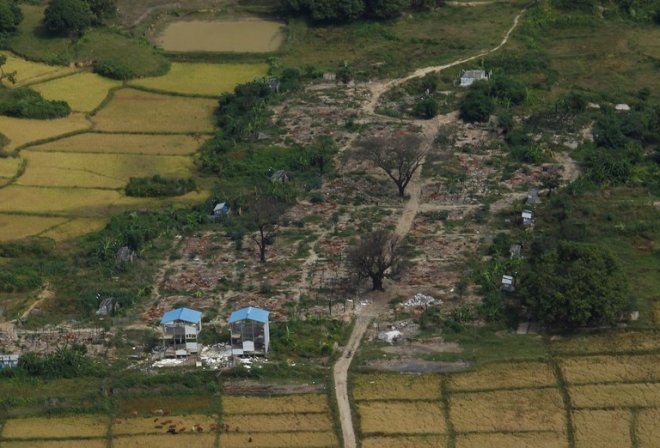 A burned Rohingya village near Maungdaw, northern Rakhine state, Myanmar, is seen Nov. 12, 2017. Picture taken November 12, 2017. Credit: Wa Lone/Reuters
A burned Rohingya village near Maungdaw, northern Rakhine state, Myanmar, is seen Nov. 12, 2017. Picture taken November 12, 2017. Credit: Wa Lone/ReutersViolence escalated dramatically in August 2017 when the Arakan Rohingya Salvation Army – a small, poorly armed resistance group – attacked security forces across northern Rakhine state, killing 12 people.
The military response, “launched within hours, was immediate, brutal and grossly disproportionate,” encompassing hundreds of villages in so-called “clearance operations.” Within a year nearly 725,000 Rohingya had fled to Bangladesh, with an estimated 10,000 people killed.
“Rape and other forms of sexual violence were perpetrated on a massive scale. Large scale gang rape was perpetrated by Tatmadaw soldiers in at least 10 village tracts” in Rakhine state, the complaint said.
Massacres
People were shot dead indiscriminately by soldiers, while others were burned to death in their homes. Rakhine men often joined the soldiers wielding long knives and machetes.
“Sometimes up to 40 women and girls were raped or gang-raped together,” often in public and in front of their families “to maximize humiliation.” Men and boys were not spared “genital mutilation and sexualized torture,” the document reads.
Of the approximately 500,000 Rohingya children currently in Bangladesh, “many fled alone after their parents were killed or after being separated from their families.”
 Rohingya refugee Nur Kamal, 17, poses for a photograph to show his head injuries, at Kutupalong refugee camp, near Cox"s Bazar in Bangladesh, Oct. 13, 2017. Kamal says soldiers “hit me with a rifle butt on my head first and then with a knife” after they found the young shopkeeper hiding in his home in Kan Hpu village in Maungdaw, Myanmar. Credit: Jorge Silva/Reuters
Rohingya refugee Nur Kamal, 17, poses for a photograph to show his head injuries, at Kutupalong refugee camp, near Cox"s Bazar in Bangladesh, Oct. 13, 2017. Kamal says soldiers “hit me with a rifle butt on my head first and then with a knife” after they found the young shopkeeper hiding in his home in Kan Hpu village in Maungdaw, Myanmar. Credit: Jorge Silva/ReutersIn a particularly heinous incident on August 30, 2017, soldiers and armed ethnic Rakhine stormed the village of Min Gyi and attacked Rohingya who had taken refuge there.
Soldiers opened fire on people trying to flee. Villagers who surrendered were rounded up, and women and children were separated from the men.
The men were slaughtered and their bodies dumped into three pits, doused gasoline and set ablaze.
Women and girls were taken into rooms where they were robbed, raped and stabbed. Children and infants were killed or stabbed.
“All interviewees identified Tatmadaw soldiers as the main perpetrators,” the complaint says, adding that ethnic Rakhine “and members of other ethnic minorities participated.”
At least 750 people died in that attack.
Downplayed
Aung San Suu Kyi, then head of Myanmar’s civilian government, downplayed the violence when presented with evidence, describing it as “fake news” and “an iceberg of misinformation.”
Two other international court cases are attempting to hold Myanmar’s authorities accountable.
In 2019 the International Criminal Court began looking into abuses against Rohingya on the border with Bangladesh. Myanmar is not a member of the ICC, but Bangladesh is, so this probe is limited in scope.
And in November 2020 The Gambia filed a case focusing on Myanmar’s responsibility as a state for the Rohingya genocide at the UN’s top court, the International Court of Justice.
“Argentina is on the other side of the world from Myanmar but even here the Burmese military cannot escape justice,” plaintiff Tun Kihn said.
Edited by Malcolm Foster.
[圖擷取自網路,如有疑問請私訊]
|
本篇 |
不想錯過? 請追蹤FB專頁! |
| 喜歡這篇嗎?快分享吧! |
相關文章
AsianNewsCast









